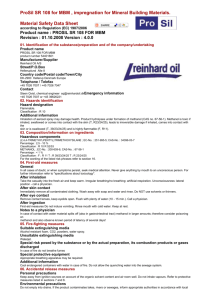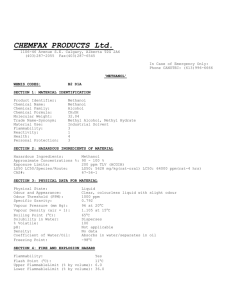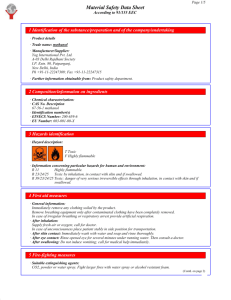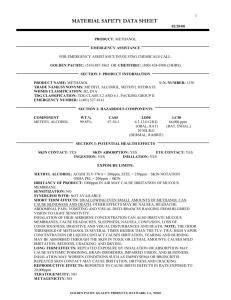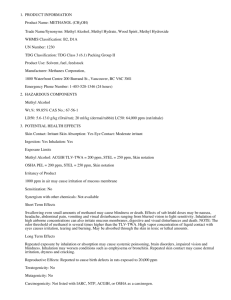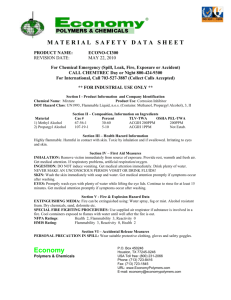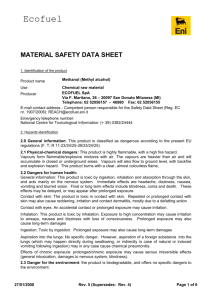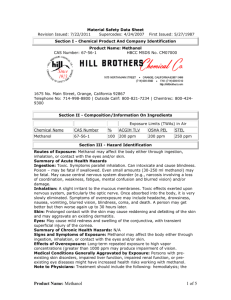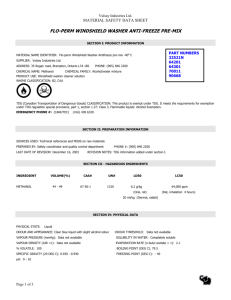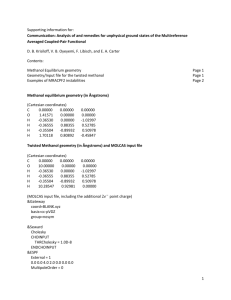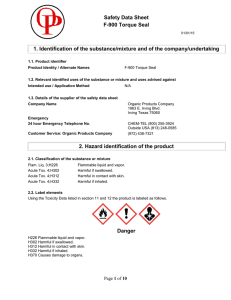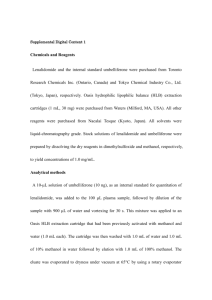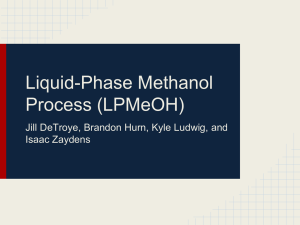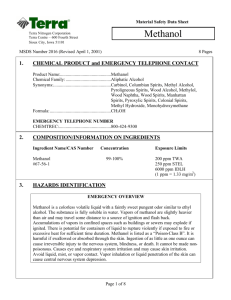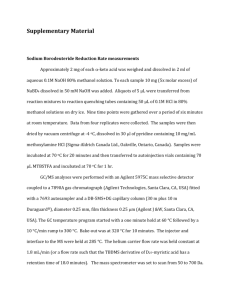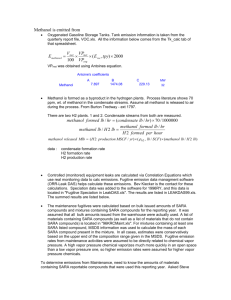material safety data sheet - Elwood Technology
advertisement
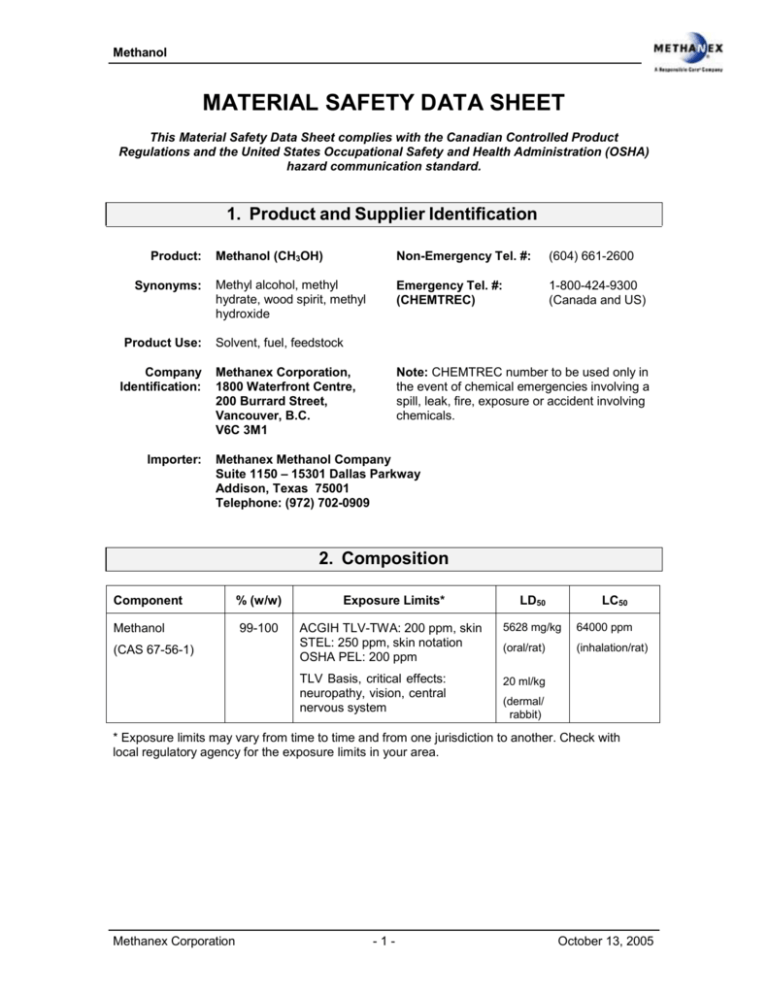
Methanol MATERIAL SAFETY DATA SHEET This Material Safety Data Sheet complies with the Canadian Controlled Product Regulations and the United States Occupational Safety and Health Administration (OSHA) hazard communication standard. 1. Product and Supplier Identification Product: Synonyms: Product Use: Company Identification: Importer: Methanol (CH3OH) Non-Emergency Tel. #: (604) 661-2600 Methyl alcohol, methyl hydrate, wood spirit, methyl hydroxide Emergency Tel. #: (CHEMTREC) 1-800-424-9300 (Canada and US) Solvent, fuel, feedstock Methanex Corporation, 1800 Waterfront Centre, 200 Burrard Street, Vancouver, B.C. V6C 3M1 Note: CHEMTREC number to be used only in the event of chemical emergencies involving a spill, leak, fire, exposure or accident involving chemicals. Methanex Methanol Company Suite 1150 – 15301 Dallas Parkway Addison, Texas 75001 Telephone: (972) 702-0909 2. Composition Component % (w/w) Exposure Limits* LD50 Methanol 99-100 ACGIH TLV-TWA: 200 ppm, skin STEL: 250 ppm, skin notation OSHA PEL: 200 ppm 5628 mg/kg 64000 ppm (oral/rat) (inhalation/rat) TLV Basis, critical effects: neuropathy, vision, central nervous system 20 ml/kg (CAS 67-56-1) LC50 (dermal/ rabbit) * Exposure limits may vary from time to time and from one jurisdiction to another. Check with local regulatory agency for the exposure limits in your area. Methanex Corporation -1- October 13, 2005 Methanol 3. Hazards Identification Routes of Entry: Skin Contact: Moderate Eye Contact: Moderate Ingestion: Major Inhalation: Major Effects of Short-Term (Acute) Exposure: Inhalation: Inhalation of high airborne concentrations can also irriate mucous membranes, cause headaches, sleepiness, nausea, confusion, loss of consciousness, digestive and visual disturbances and even death. NOTE: Odour threshhold of methanol is several times higher than the TLV-TWA. Depending upon severity of poisoning and the promptness of treatment, survivors may recover completely or may have permanent blindness, vision disturbances and/or nervous system effects. Concentrations in air exceeding 1000 ppm may cause irritation of the mucous membranes. Skin Contact: Methanol is moderately irritating to the skin. Methanol can be absorbed through the skin and harmful effects have been reported by this route of entry. Effects are simialr to those described in “Inhalation” Eye Contact: Methanol is a mild to moderate eye irritant. High vapour concentration or liquid contact with eyes causes irritation, tearing and burning. Ingestion: Swallowing even small amounts of methanol could potentially cause blindness or death. Effects of sub lethal doses may be nausea, headache, abdominal pain, vomiting and visual disturbances ranging from blurred vision to light sensitivity. Effects of Long-Term (Chronic) Exposure: Repeated exposure by inhalation or absorption may cause systemic poisoning, brain disorders, impaired vision and blindness. Inhalation may worsen conditions such as emphysema or bronchitis. Repeated skin contact may cause dermal irritation, dryness and cracking. Medical Conditions Aggravated By Exposure: Emphysema or bronchitis. 4. First Aid Measures Note: Emergency assistance may also be available from the local poison control centre. Eye Contact: Remove contact lenses if worn. In case of contact, immediately flush eyes with plenty of clean running water for at least 15 minutes, lifting the upper and lower eyelids occasionally. Obtain medical attention. Skin Contact: In case of contact, remove contaminated clothing. In a shower, wash affected areas with soap and water for at least 15 minutes. Seek medical attention if irritation occurs or persists. Wash clothing before reuse. Inhalation: Remove to fresh air, restore or assist breathing if necessary. Obtain medical attention. Ingestion: Swallowing methanol is potentially life threatening. Onset of symptoms may be delayed for 18 to 24 hours after digestion. If conscious and medical aid is not immediately Methanex Corporation -2- October 13, 2005

